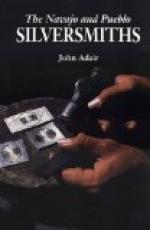[Illustration: Pl. XVII. Workshop of Navajo silversmith.]
A little instrument employed in levelling the edges of the metallic hemispheres, is rude but effective. In one end of a cylinder of wood, about three or four inches long, is cut a small roundish cavity of such a size that it will hold the hemisphere tightly, but allow the uneven edges to project. The hemisphere is placed in this, and then rubbed on a flat piece of sandstone until the edges are worn level with the base of the wooden cylinder. The uses of the basin and the wooden stake are described further on.
Their method of preparing charcoal is much more expeditious than that usually employed by our charcoal-burners, but more wasteful; wood, however, need not yet be economized on the juniper-covered mesas of New Mexico. They build a large fire of dry juniper, and when it has ceased to flame and is reduced to a mass of glowing coals, they smother it well with earth and leave it to cool. If the fire is kindled at sunset, the charcoal is ready for use next morning.
The smith makes his own blow-pipe, out of brass, usually by beating a piece of thick brass wire into a flat strip, and then bending this into a tube. The pipe is about a foot long, slightly tapering and curved at one end; there is no arrangement for retaining the moisture proceeding from the mouth. These Indians do not understand our method of making an air chamber of the mouth; they blow with undistended cheeks, hence the current of air directed on the flame is intermitting. The flame used in soldering with the blow-pipe is derived from a thick braid of cotton rags soaked in mutton suet or other grease. Their borax is purchased from the whites, and from the same source is derived the fine wire with which they bind together the parts to be soldered. I have been told by reliable persons that it is not many years since the Navajos employed a flux mined by themselves in their own country; but, finding the pure borax introduced by the traders to be much better, they gradually abandoned the use of the former substance.
For polishing, they have sand-paper and emery-paper purchased from the whites; but as these are expensive, they are usually required only for the finishing touches, the first part of the work being done with powdered sandstone, sand, or ashes, all of which are used with or without water. At certain stages in the progress of the work, some articles are rubbed on a piece of sandstone to reduce the surfaces to smoothness; but the stone, in this instance, is more a substitute for the file than for the sand-paper. Perhaps I should say that the file is a substitute for the stone, for there is little doubt that stone, sand, and ashes preceded file and paper in the shop of the Indian smith.
For blanching the silver, when the forging is done, they use a mineral substance found in various parts of their country, which, I am informed by Mr. Taylor, of the Smithsonian Institution, is a “hydrous sulphate of alumina,” called almogen. This they dissolve in water, in a metal basin, with the addition, sometimes, of salt. The silver, being first slightly heated in the forge, is boiled in this solution and in a short time becomes very white.




